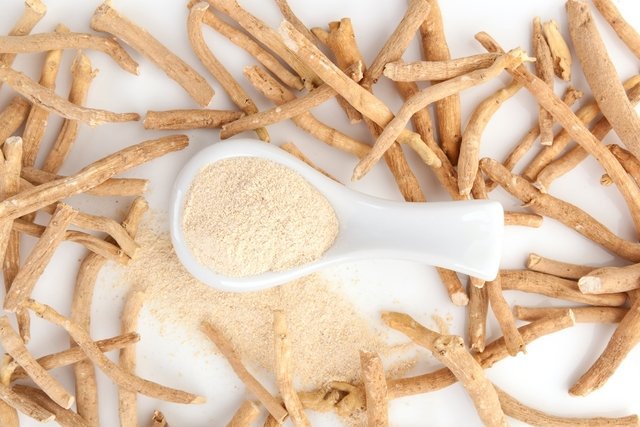Ashwagandha (botanical name: Withania somnifera, common name: Indian Ginseng) is a medicinal plant with calming, anti-stress and anti-inflammatory properties. It is used to help improve physical and mental performance and to reduce anxiety. It can also be used for stress management or general fatigue
The part of the plant that is usually used is the root, which can be consumed in the form of tea, capsules or liquid. These forms can be found in herbal stores, natural health product stores, pharmacies, and some street markets.
Ashwagandha should only be used under the supervision of a doctor or health professional who has experience with the use of medicinal plants. This is because when it is consumed in excess it can cause headaches or diarrhea. It is also not indicated for pregnant or breastfeeding women.

Main health benefits
Ashwagandha has anti-hyperglycemic, anti-inflammatory, antioxidant, calming and anxiolytic properties, which can lead to several health benefits such as:
1. Increasing libido
Some studies show that ashwagandha can help increase sexual desire because it helps regulate hormones, promoting better functioning of the reproductive organs. In can promote natural lubrication in women and increase overall pleasure during sex.
In addition, ashwagandha can help reduce stress and anxiety, which are often associated with a decrease in libido in both women and men.
2. Increasing fertility
According to some studies, ashwagandha can help increase fertility in men by increasing testosterone production, which leads to an increase in the quantity and motility of sperm.
In addition, ashwagandha can help increase fertility in women by improving hormonal balance, promoting better functioning of the reproductive organs and strengthening the uterus in women with a history of miscarriages.
However, more studies are needed to prove this benefit.
3. Reducing stress and anxiety
Ashwagandha contains substances such as sitoindosides and acylsterylglycosides with adaptogenic action. These help to reduce stress and anxiety by decreasing cortisol production of cortisol, which is a hormone that is released in greater quantities during periods of stress.
In addition to its adaptogenic action, ashwagandha also has substances that act on the central nervous system similarly to the neurotransmitter GABA. It helps to increase the body's sense of relaxation and reduce symptoms of anxiety and stress such as agitation, nervousness, mental fatigue or difficulty concentrating.
4. Fighting insomnia
Ashwagandha can help improve sleep quality and reduce the anxiety that can often contribute to difficulty sleeping. In this way, this medicinal plant can be useful in helping to combat insomnia.
In addition, by improving sleep quality and fighting insomnia, this medicinal plant also helps to improve energy levels and alertness during the day. Check out other herbs for insomnia that you can use to help you achieve a better night's sleep.
5. Improving memory
A study carried out on adults taking 600 mg of ashwagandha extract a day for 8 weeks showed that this medicinal plant can help improve memory, attention and the speed at which the brain processes information.
In addition, due to its antioxidant effects, ashwagandha can help reduce the damage caused by free radicals to the brain, helping to improve its functioning and cognitive and motor capacity.
Although ashwagandha has benefits for memory, more studies are needed to prove this.
6. Improving muscle performance
Ashwagandha can help improve muscle performance during physical activity, because this medicinal plant can help increase muscle strength and mass, as well as optimize the use of oxygen by the muscles.
7. Boosting immunity
Ashwagandha is rich in alkaloids, lactones and saponins that have anti-inflammatory, antioxidant and immunomodulatory properties. These help to strengthen the immune system, preventing and helping to fight infections.
8. Managing blood sugar
Ashwagandha has substances in its composition, such as witaferin-A, with anti-glycemic properties. They help control blood glucose levels by stimulating the cells to use the glucose circulating in the blood.
In addition, some studies carried out in the laboratory on human cells have shown that ashwagandha helps reduce blood glucose and glycated hemoglobin levels, which can be useful for controlling diabetes.
However, it is important to note that ashwagandha is not a substitute for the diabetes treatment prescribed by your doctor. Learn more about the diabetes medication your doctor may prescribe.
9. Preventing cardiovascular disease
The alkaloids, steroid lactones and glycosides present in ashwagandha have an antioxidant action which help to reduce bad cholesterol, which is responsible for forming fatty plaques in the arteries. This medicinal plant can therefore help to reduce the accumulation of fat in the blood vessels and reduce the risk of cardiovascular diseases such as atherosclerosis, heart attacks and strokes.
However, regular consumption of ashwagandha does not replace medical treatment with medication and does not exclude the need to maintain a healthy, low-fat diet. Check out the low cholesterol diet your doctor or registered dietitian may prescribe.
10. Helping to treat cancer
Some studies carried out on cells or animals in the laboratory indicate that ashwagandha has properties that have been shown to be effective in helping to treat different types of cancer, such as breast, pancreatic, lung, cervix and skin, for example. However, more studies are still needed to confirm these properties.
How to use Ashwagandha
The root is the part of the plant obtained when using this plant. It contains active substances that can be extracted and can be consumed in the form of tea, capsules, or a fluid extract.
The main forms of using ashwagandha are:
- Capsules: take one pill of 500 mg, once or twice a day with meals;
- Fluid extract: take between 2 and 4 ml (40 to 80 drops) diluted in water, once a day;
- Ashwagandha tea: mix 1 teaspoon of dry Ashwagandha root in 120 ml of boiling water. Let it infuse for 15 minutes, strain, and then take it while it’s still warm. It is recommended that you drink one cup per day, for a maximum of six months.
The duration of the ashwagandha treatment depends on the doctor’s recommendation.
Possible side effects
Ashwagandha is safe when consumed in the quantities recommended by the doctor and for a maximum of six months. When consumed too frequently, in a dosage that is superior to what is recommended, or for more than six months, there may be some side effects such as stomach pain, diarrhea, or vomiting.
Some studies suggest that taking ashwagandha can cause liver disease, like hepatitis or jaundice. These types of conditions can start two to twelve weeks after the initial use of this medicinal plant. If these conditions appear, the symptoms will be yellow skin, yellow eyes, and intense itchiness in the body.
Contraindications to consider
Ashwagandha should not be taken by pregnant or breastfeeding women, by people with autoimmune diseases such as rheumatoid arthritis or lupus, or by people with stomach ulcers.
In addition, ashwagandha may reduce blood pressure and interfere with blood pressure treatment in people with hypertension. It can also drastically reduce blood sugar levels, and can especially cause hypoglycemia in diabetics.
Because ashwagandha has a sedative effect, people who are already taking medication for anxiety or depression should avoid this medicinal plant, as it can cause excessive sleepiness.
